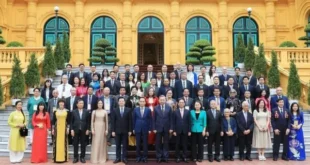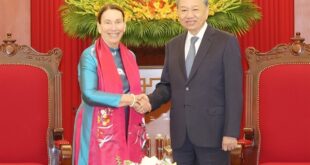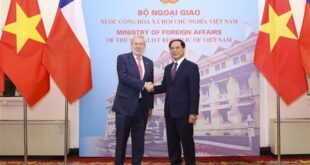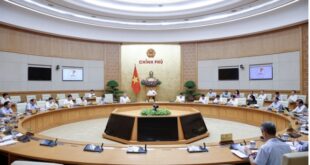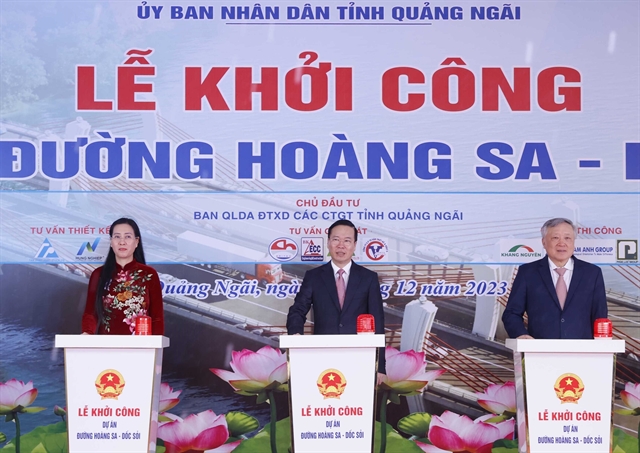
|
| President Võ Văn Thưởng attends the ceremony announcing Quảng Ngãi’s master plan for 2021-2030, with a vision to 2050 on Sunday. — VNA/VNS Photo Thống Nhất |
QUẢNG NGÃI — The central province of Quảng Ngãi on Sunday announced its master plan for 2021-2030, with a vision to 2050, during a ceremony attended by President Võ Văn Thưởng and Deputy Prime Minister Trần Hồng Hà.
The plan is viewed as an important instrument in guiding the province’s direction and management in socio-economic development and spatial planning, ensuring cohesion and optimisation of the local strengths and potential while also addressing the bottlenecks for balanced, effective and sustainable growth.
Speaking at the ceremony, Deputy PM Hà said that Quảng Ngãi is part of the central key economic zone, with a strategic location and a transportation system that connects national routes to the Central Highlands region and southern Laos.
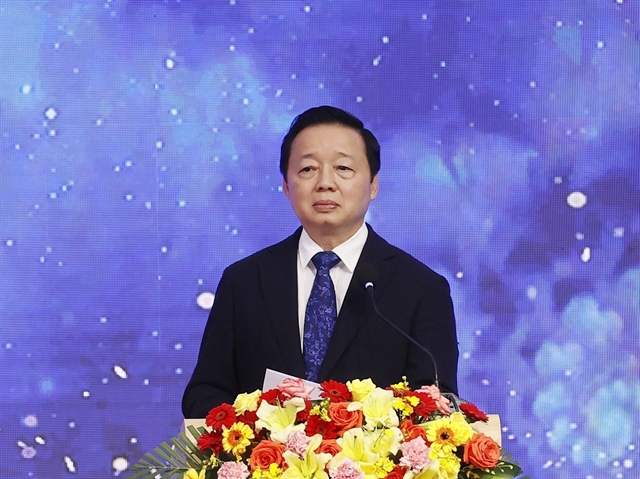
|
| Deputy Prime Minister Trần Hồng Hà addresses the ceremony in Quảng Ngãi on Sunday. — VNA/VNS Photo Thống Nhất |
With a 130km coastline, Quảng Ngãi has tremendous potential for the marine economy. Its Dung Quất deep-water seaport is an integrated, multi-industry economic zone with an oil refinery, national energy, mechanic-metallurgy and logistics centres.
The province is also known for the ancient Sa Huỳnh Culture that dates back 2,500 to 3,000 years, and a profound tradition of patriotism during war times.
Initially a locality with modest resources, Quảng Ngãi has seen dynamic development and become an industrial centre of the south-central coastal region. Its gross regional domestic product (GRDP) now places fourth out of 14 provinces in the north-central and the south-central coastal regions.
Deputy PM Hà underlined that the Quảng Ngãi master plan is part of the implementation of the Politburo’s Resolution 26 and is expected to create new momentum for the province’s growth in the new context.
He also noted that the plan needs to address the bottlenecks and challenges in Quảng Ngãi’s development, such as economic growth dependent on resource-intensive industries, shortage of high-quality human resources, untapped potential in terms of nature, cultural traditions and human capital and climate change impacts.
The deputy PM recommended sustainable urban planning, selecting a suitable development model and forming an urban economic-industrial-service ecosystem, while also paying attention to rural and agricultural economic development in the direction of high technology and production.
The province should also develop tourism services based on its strength in culture, heritage, sea and islands and diverse natural ecosystems.
Focusing on the balance of sustainable economic-social-environmental development and a systematic, multidimensional approach, Quảng Ngãi presented three key strategic visions in its master plan.
These include Quảng Ngãi’s development based on the province’s unique advantages – aiming for a distinctive sustainable growth mode; Quảng Ngãi – a new, specialised destination in the central region’s key economic zone; and Quảng Ngãi leveraging its strengths to become a logistics centre of seaports, marine economy and the East-West economic corridor.
By 2030, Quảng Ngãi aims to become a well-developed province with an income per capita equal to the national average or more.
The province also strives for an average GRDP growth rate of 7.25-8.25 per cent per year, with GRDP per capita falling between US$7,700-7,900.
The urbanisation rate is expected to top 50 per cent, while the goal for total social investment capital is around VNĐ410 trillion ($16.9 billion).
Quảng Ngãi’s human development index (HDI) is expect to remains in the medium-high group (Group 2) in accordance with the categorisation of the United Nations Development Programme (UNDP).
Forest coverage is set to be stable at around 52 per cent.
The province also aims to supply clean water to 100 per cent of its urban population and 80 per cent of its rural population.
For level-2 urban areas, the percentage of urban wastewater collected and treated according to standards and regulations is expected to reach 50 per cent. This figure is set at 20 per cent for the remaining urban areas.
At the ceremony, Quảng Ngãi also presented approval decisions to investors of a number of urban development and industrial gas production projects in the province. — VNS
- Reduce Hair Loss with PURA D’OR Gold Label Shampoo
- Castor Oil Has Made a “Huge” Difference With Hair and Brow Growth
- Excessive hair loss in men: Signs of illness that cannot be subjective
- Dịch Vụ SEO Website ở Los Angeles, CA: đưa trang web doanh nghiệp bạn lên top Google
- Nails Salon Sierra Madre
 VnExpress News The News Gateway of Vietnam
VnExpress News The News Gateway of Vietnam
